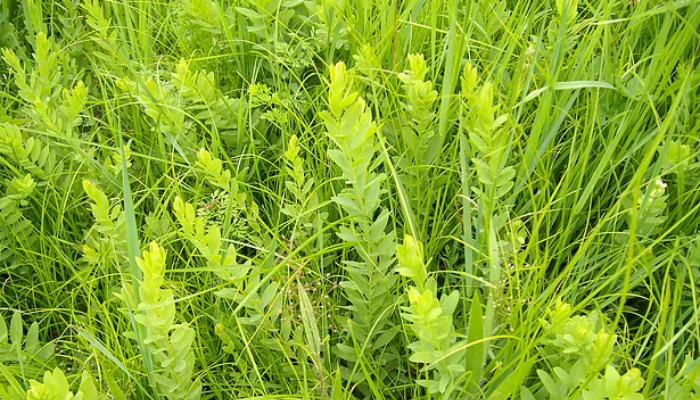The Power of Bastard Toadflax

The rain is spitting harder now, and I can feel the damp cold penetrating openings in my rain gear. This gloomy weather matches my mood. I’m standing in a thick tangle of blackberry canes and Canada goldenrod feeling bummed that after a decade of work, we are still struggling to get rid of this stuff. I tear ahead through the thorny mess thankful for my brush chaps’ armor. Shortly, the sea of thorns gives way to a large opening. As if on cue, the rain stops, and sun peaks out. Before me is a shin-high carpet of vegetation dotted with colorful flowers such as alumroot, pale-spiked lobelia, arrow-leaved violet, bird’s foot violet and northern bedstraw. The power of the bastard, I muse.
Bastard toadflax, Comandra umbellata, is a hemi-parasitic plant that receives nourishment both from a host plant and photosynthesis. It’s considered a generalist and will parasitize many herbaceous and woody species. It can form large, dense clones by underground rhizomes. Similar to wood betony (see blog post on wood betony), bastard toadflax’s ability to parasitize and weaken dominant plant species allows room for other plants that would normally be suppressed or absent altogether.
A practitioner must tread carefully with herbicide use, as irreversible damage may occur. For example, the one rare plant present in the entire remnant prairie may be hidden under the bramble patch you just sprayed! This mix of good plants with bad plants in a recovering prairie makes for difficult and prolonged management control efforts. Fortunately, for this prairie remnant, we are being aided by thousands of bastard toadflax commandos doing the heavy hitting for us. And the result is a slow, but sustainable, increase in native plant biodiversity unmatched by any of our other management efforts such as herbicide treatment or mowing.
Unfortunately, with bastard toadflax, seed production is very low. Rarely is the seed commercially available. In the past 12 years, I have only found a small quantity of seed twice in the patches I monitor. I have tried direct seeding, inserting seeds into little bluestem grass plugs and a few other techniques, and all have resulted in zero plants thus far. Transplanting bastard toadflax can be successful if care and attention to details is followed. However, most transplants lead to failure, and it’s unethical to be digging up toadflax plants in our rare prairie remnants.
Ecologically restoring our few remaining prairie remnants is a great challenge. Also challenging is reconstructing (planting) these rare ecosystems in lands such as former agricultural fields. In our quest to bring back as much sustainable biodiversity as possible, practitioners must use their powers of observation and capitalize on positive plant-to-plant interactions. Only by leveraging these species-to-species relationships can we move forward with increasing biodiversity and sustainability while decreasing management activity input.
Bastard toadflax, and I suspect many other plant and animal species, holds the secrets to unlocking the former glory of the prairie. Can we, as practitioners, slow down long enough to discover them?
Originally published in Environmental Returns.
Tags: bastard toadflax, David Cordray, prairie restoration

